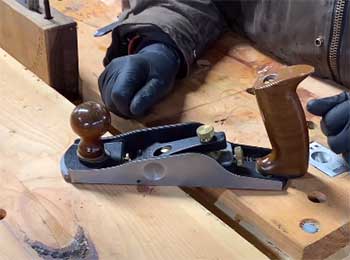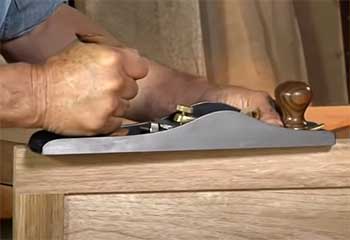Veritas offers two essential woodworking tools, a low angle smoother and a bevel-up smoother. But which one will you select if you have to choose one?
You might become confused. If so, this comparison guide will help you identify the best tool for your project.
Veritas low angle smoother has a 12° angle bed and 25° bevel blade, whereas the bevel-up smoother has a 12° angle bed with a 38° blade bevel. There are many other differences that you will learn in the latter part.
So, let’s get started.
A Quick Comparison Table
Here is a quick comparison table between Veritas low angle smoother and Bevel-Up smoother:
| Aspects | Low-Angle Smoother | Bevel-Up Smoother |
| Smoother Type | Low-Angle Smoother Plane | State-Of-The-Art Smoothing |
| Special Feature | Has A Cast Iron Body | Comes With A Balanced Width And Weight |
| Benefits | Offers Many Benefits | Offers Many Benefits |
| Available Variants | 3 Available Variants | 3 Available Variants |
| Price | Around $235-$247 | Around $262-$275 |
In-Depth Comparisons Between Low Angle Smoother And Bevel-Up Smoother
Now we will get into more detailed comparisons between these two smoothers. You can make the right choice after knowing all the nitty-gritty about them.
So, here are some key differences between these two woodworking tools:
- Product Type

Both of them are wood smoothers manufactured by the same company Lee Valley Tools Ltd.
A low-angle smoother and bevel-up smoother complements each other on various wood smoothing tasks.
However, A Veritas low-angle smoother plane has broadside wings that can shoot miters and smooth wooden surfaces.
Its 37° cutting low angle makes it an excellent tool for end-grain work.
Besides, you can effectively minimize fiber tearing because of its lower angle.
On the other hand, Bevel-up is a newer addition to the Veritas wood smoothing tool army. This state-of-the-art smoothing tool gives your wood surface a final finish.
Especially, it works excellently on woods with difficult grain patterns. The 50° cutting angle yields an effective cutting performance.
- Features
The low-angle Veritas smoother has a cast iron body with a generous amount of side wings. It comes with an adjustable mouth and a unique stop-screw.
Besides, a lateral adjustment knob to change blade settings, a combined feed, a wooden polished rear handle, and a front knob make this tool easier to handle and work with.
On the contrary, a bevel-up smoother has a balanced width and weight. It has a coffin-shaped body made from fully stressed released ductile cast iron.
A low center of gravity offers excellent stability and smooth cutting performance. This tool is designed precisely and has a flat and square sole to the side.
- Benefits

As both of them are very high-quality wood smoothers, no wonder you’ll get excellent benefits from them.
Let’s see what you’ll get from these tools.
The manufacturer offers lapped 38° and 50° blades as well as a tooth A2 blade separately for both tools so that you can work with difficult wood grains.
Because of the low cutting angle, a low-angle smoother plane reduces fiber tearing during a project. So you’ll have less wastage, and you can smoothly finish end-grain work.
You will get an adjustable mouth close to a narrow slit and give you a nice and smooth cut. Plus, it also produces less tear during heavy-duty use.
The set screws will keep the blade firmly in place but allow total lateral adjustment simultaneously.
- Available Variants
Veritas Low-angle and Bevel-up smoothers are available in three variants. The variants of Low-Angle smoother are A2, O1, and PM V-11.
On the other hand, three options for bevel-up smoother are Bevel-Up Smoother Plane A2, Bevel-Up Smoother Plane O1, and Bevel-Up Smoother Plane PM-V11.
As you can see, variant names are the same for both wood smoothers.
- Price
The first two variants of low-angle smoother cost $235, but PM-V11 costs $247. Conversely, you will have to spend $262 for the first two variants of bevel-up smoother.
But the last variant will cost $275. Bevel-up is more expensive compared to low-angle smoother.
Which Smoother Is Best For You?
My above discussion says both low-angle and bevel-up smoothers can provide excellent cutting performance.
Low-angle smoother was introduced before bevel-up smoother came into the market. With different blade angles, they provide slightly different performance.
You can use bevel-up more smoother as it’s the latest model with advanced design. But Bevel-up has been designed to complement the low-angle smoother.
So, the best way is to use them together for optimum cutting performance. Having both tools will allow you to cut smoother stocks and work with wood that has difficult wood grain patterns.
Frequently Asked Question (FAQ)
The low angle in a low-angle smoother means the bed of the smoother lays low. The bevel-up means the blade orientation of a smoother. So, you will have to up or down your bevel depending on the wood type.
A bevel-up plane is used for smoothing wood surfaces. You can make your wood surfaces smooth and ready for use with a smoother. A bevel-up smoother can adjust the blade height so that you can smooth difficult-to-reach spots with this woodworking tool.
A bevel-up plane wood smoother has a 12° bed angle, and the blade can bevel 38°. You can effectively cut at a maximum of 50°. Because of this adjustable angle, bevel-up smoothers can effectively cut a surface and produces less tear-up.
Setting up a Veritas low angle jack plane is relatively easy. You will have to adjust the blade firmly in place so that it doesn’t move around. Use the stop-screw to adjust the mouth.
Final Thoughts
You can efficiently finish your woodworking projects with the suitable wood smoother. The right tool can save you time and make life easier. So, you cannot but use the right tool.
After reading the differences between Veritas low angle smoother vs. Bevel-Up smoother, I hope you have a clear picture now. I am confident that now you will make the right choice.
